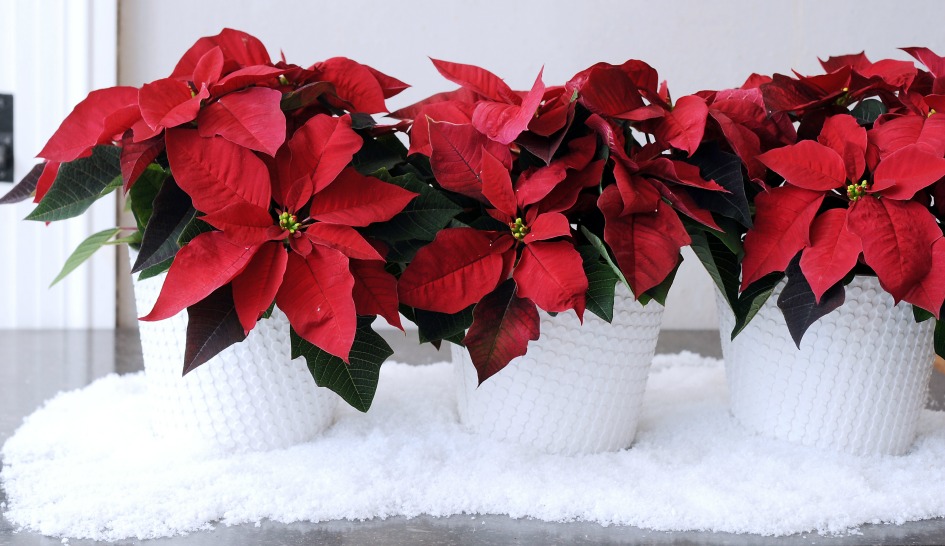The Poinsettia – A Remarkable plant all year round!
Posted by:
 scentandviolet
December 12th, 2023
scentandviolet
December 12th, 2023
Poinsettia plant is a staple in many homes during the Christmas season, with their vibrant red and green leaves adding festive cheer to any space. But did you know that this popular plant has a rich history dating back hundreds of years?
Poinsettia History
The poinsettia plant, also known as Euphorbia pulcherrima, is native to south Mexico and Guatemala, and was first brought to the United States in the 1800s by Joel Poinsett, a botanist and diplomat. Mr. Poinsett was serving as the first US Minister to Mexico when he became enchanted by this beautiful plant and sent some back home to his family in South Carolina.
While poinsettias have become synonymous with Christmas, they actually have a deeper cultural significance in Mexico. Native Aztecs and Mayas used poinsettia plant to make a red dye for textiles and cosmetics, as well as using its milky sap for medicinal purposes. They also believed that the plant had mystical properties.
In the 16th century, Spanish priests in Mexico began incorporating poinsettias into their Christmas celebrations, using poinsettia flower as a symbol of the Star of Bethlehem. This is how the plant came to be associated with the holiday season.
Modern Poinsettia Cultivations
German emigrant Albert Ecke began cultivating poinsettias in Eagle Rock, LA in 1909. In the 1920’s, his son Paul Ecke Sr. was growing poinsettias in the Hollywood and Beverly Hills area. In 1924, he relocated his farm to Encinitas, California and grew filed poinsettia mother plants used for cuttings by commercial growers. In 1963, Ecke began growing the plants in greenhouses, producing small cuttings in a controlled environment. The cuttings were then shipped worldwide by air freight. Ecke Family sold their business to what is now known as Dummen Orange but their name still resonates with many poinsettia growers in the USA.
Today, poinsettias are the best-selling potted plants in the United States. They come in a variety of colors, including white, pink, and marbled varieties. And while potted plant may only last for a few weeks indoors, these beautiful plants can be grown outside in warmer climates where they can reach up to 16 feet in height.

Poinsettia Care
Poinsettias are easy to care for, too. They prefer indirect, natural light, especially during the shorter days of winter. Protect them from cool drafts and extreme temperatures. Water them in the sink, let them sit for five minutes, then discard any excess water. You may need to water every day, just pay attention, and don’t let them dry out completely.
You can keep your Poinsettia all year round! Don’t fertilize your Poinsettia while it’s blooming but in the spring while the plant is growing, begin to feed the plant once a month with any water-soluble plant food. New foliage should begin to appear about six weeks after blooming ceases. You can repot your poinsettia into a slightly larger pot in the spring. Just use regular potting soil while repotting and enjoy! This plant makes a wonderful compliment to any home and will surely bring a smile once gifted to that special someone.
Poinsettia Propagation
To propagate poinsettia plant, you will need a healthy parent plant with vibrant leaves and a stem that is at least 14-16 inches long.
Begin by taking a cutting from the parent plant. Make sure to use a clean, sharp knife or scissors to make a clean cut just below the leaf node (the spot where the leaf attaches to the stem). Remove any excess leaves from the bottom half of the cutting, leaving only a few at the top.
Next, prepare a pot with well-draining soil (regular potting soil from any garden center will do. Please do not add peat moss). Dip the cut end of your cutting in rooting hormone (this is only if you have any at hand, no need to purchase any) and place the cutting in the pot, making sure that at least one leaf node is covered by the soil. Water the cutting lightly.
To encourage root growth, it's good to keep the cutting in a warm, humid environment. You can cover the pot with a clear plastic bag or place it in a mini greenhouse if you have one. Keep the soil slightly moist but not waterlogged. It is much easier to propagate poinsettia in the soil instead of water.
After a few weeks, your poinsettia cutting should start to develop new leaves and roots. Once the roots are at least an inch long (4-6 weeks) it's time to transplant your new plant into a larger pot with regular potting soil. Keep the plant in bright, indirect sunlight and water it regularly.
***
Scent & Violet, flowers and gifts is a full service florist in Houston, TX located at 12811 Westheimer Rd. We aim to create fuss-free, everyday shopping source for flowers, plants, and gifts. It is our belief that we can create better relationships through gifting, better environments through plants, and better state of mind through flowers.

